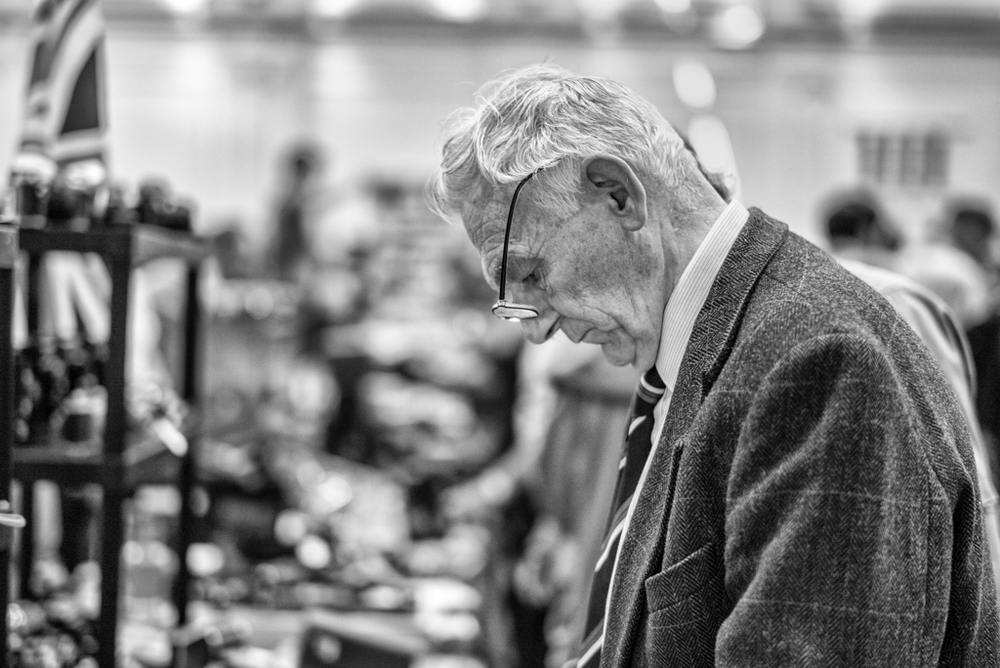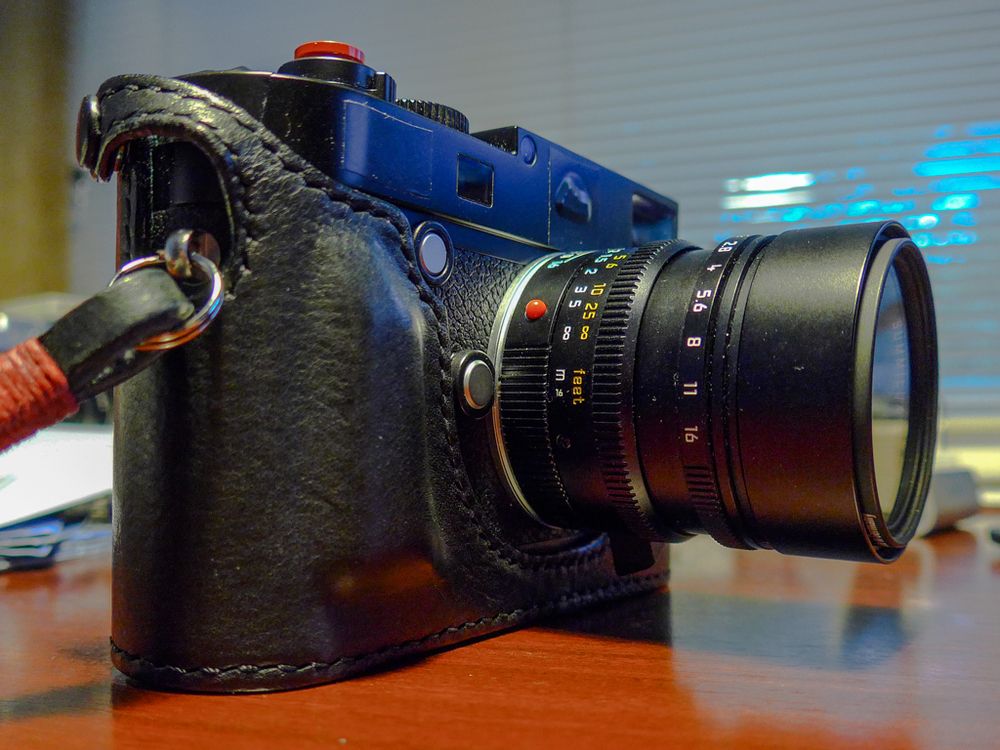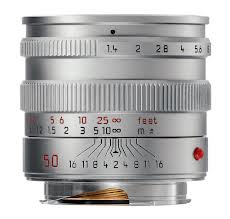
Ask any group of street photographers what lens they prefer working with and the overwhelming answer will be a 35mm. Although the great exponents of the art, such as Henri Cartier-Bresson, mainly used a fifty, considered to be the “normal” angle of view, in recent years the thrust has been towards the wider-angle thirty-five. The modern street tog needs to get friendly with strangers, preferably right in their faces.
Last year when I walked up Oxford Street with Eric Kim and Charlie Kirk I had my 35mm Summicron focus set to 70mm, the minimum distance possible, and was encouraged to get really close to subjects. It worked, to a point, but I was not entirely comfortable. This was surprising. I have been using 35mm almost exclusively for street photography for the past two years. I love my Fuji X100S where I have no choice but to use 35mm. Most of the time it is fine.

A bit longer
Recently, though, I’ve had a hankering for something longer: The traditional “standard” lens, the nifty fifty. On balance I think I prefer to be just a little detached from the action and the 50mm focal length is pretty damn ok. I’ve even tried a 75mm APO Summicron and, unsurprisingly, this is capable of producing some good street shots. But I now tend towards 50mm (full-frame equivalent, of course) as the ideal go-anywhere walk-around lens.
But which lens to choose for a Leica owner? In the modern lens lineup there are two common choices, the f/2 Summicron and the f/1.4 Summilux. The Noctilux (f/1.0 or f/0.95) is an esoteric beast which can also produce stunning results. But it can bring focus problems and it is a large, heavy lens and by no means unobtrusive for street use.
Most people believe the Summicron is the best go-anywhere choice, whether in 35mm or 50mm form. I like the small size and low weight but I certainly do not like the lack of a focus tab on the latest 50mm Summicron. This is a deal breaker for me and, until I can afford the new and fabulously expensive APO Summicron (which does have a tab among other attributes) I much prefer to use the faster 50mm Summilux. It is truly a lens for all occasions and it is one of the sharpest and finest optics in the Leica collection.

Where there’s brass….
For the past four weeks I have been using a magnificent chrome example of the nifty fifty on my M and enjoying it immensely. This is one good looking lens, even on a black camera, but comes into its own on a silver M of any age. While I seldom use the fastest f/1.4 aperture for street work–I usually work between f/5.6 and f/8―the Summilux is such a joy to use that I can overlook its added weight and length over a Summicron. I can overlook its weight up to a point. But the lens I have been using is on the heavy side because of the solid brass build. At 460g it is even heavier than the APO Summicron seventy-five.
I love this lens so much that I have borrowed a black version which is a full 125 grams lighter than the brick-outhouse chrome lens. It is a revelation. The M feels much better balanced with the lighter version of the Summilux and, all round, the ergonomics are superb. I have taken to carrying around the M and Summilux fifty plus the much lighter and nimbler Fuji X100S, the archetypal street tog’s tool, and I now have the best of both worlds: Close and friendly thirty five and one of the best 50mm lenses ever made.

Interesting post! I’ve had the 50mm Summilux ASPH glued on my M for a while now too, and alternate between that and a well-used X100. I don’t do that so much for the different field of view (I gravitate to the 50mm more), but rather the ease of just grabbing the X100, no strap/bag/case/other lens to mess with or carry. It’s fun and really there’s less fuss overall. Plus, the Fuji is less precious and that’s nice.
I love the results from the Summilux ASPH but not so much the focus feel for fine adjustment. That little bit of stickiness people experience sometimes gets on my nerves as well. The other options out there (there are many as we know), like the Summicron or something like the C Sonnar Zeiss feel much nicer/smoother to me. I thought I’d part with the Zeiss C Sonnar after getting the Summilux but never did due to the fact that with it as with the Fuji X100 there’s less fuss and great results to be had in the overall experience. Take care!
Snap! Yes, I should have mentioned the slightly focus ring stickiness which is definitely noticeable but on when doing a straight back-to-back comparison with the Summicrons. It doesn’t worry me, otherwise it would have been nearer the front of my brain when I wrote the article. It’s a good point, though, and something for people to check when choosing ‘Cron or ‘Lux. I have had only a brief play with the APO Summicron 50 and I can’t remember if the focus ring behaves just like the current 50 Summicron–ie a bit lighter than the Summilux. I had a Zeiss 50mm f/1.5 for a time but sold it because I didn’t like the (optional and expensive) hood and I got fed up with changing the lens settings because of the absence of 6-bit coding. Of course, the Zeiss can be coded but it is an extra expense. Nice lens, though.
As for the Fuji, I agree entirely with you that it is "less precious" and therefore something to carry without too much worry. It is indeed a fun camera and the results (especially the Fuji jpegs) are outstanding.
Thanks for an interesting read as ever. Being equally indecisive in my required FOV, I have just added a Fuji X-Pro1 + 35/1.4 to my X100s, giving me roughly the same choices as you. I don’t yet carry both at the same time, making this choice instead before heading out the door. I’ll be shooting candids at a friend’s wedding tomorrow, so I’m looking forward to using both. Wish me luck!
That Fujinon 35/1.4 is one of the best lenses out there. I would go so far as to say it is right up there with the Leica Summilux and at about 1/7th of the price. My only beef with the Fuji lenses is the rather wayward fly-by-wire manual focus which causes you to twiddle for ever, often sinking in a sea of bokeh because you can’t remember which way to turn the thing. This is the one reason I would but I Leica lens on the Fuji, but only if I needed manual focus. Good luck with the wedding shots.
Cheers Mike. I’ve always used manual focus with the x100s, but will give auto focus a try with the X-Pro / 35. The Fuji lenses have a great reputation, though I hear there’s a lot of in camera correction going on. On the other hand, I’ve read that even Leica is going down that route with the new T mount lenses?
On the contrary, I more or less always use autofocus on the X100S. Perhaps I should give manual a try. I have to say that in general I prefer manual focus on a Leica M (no choice, of course, but it works well).